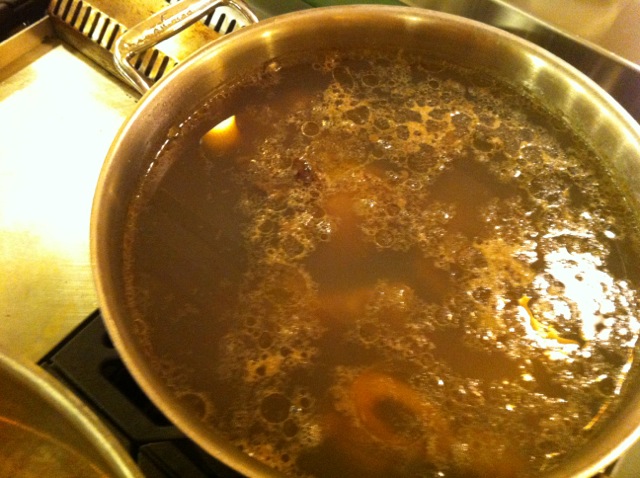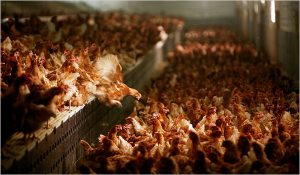Bone broth is stock or broth made from the bones, hooves, knuckles, carcasses and tough meat of chicken, fish or beef. Hooves, knuckles and heads produce the most gelatin. Bone broth has been used since the beginning of time for various health concerns such as: cancer, diabetes, digestive problems in babies (when added to their milk), infectious diseases, jaundice, muscle diseases, nurturing the sick, osteoporosis/osteopenia, peptic ulcers, pregnancy, sore throats and tuberculosis.
Chefs prize bone broths as a magic elixir for the best soups and sauces. Meat and fish stocks have been used around the world for all kinds of traditional cuisines. Because we are such a fast-food nation these days, stock has almost disappeared from American eating.
 Bone broths contain minerals the body can absorb easily. Not just calcium mind you but also magnesium, phosphorus, silicon, sulfur and other trace minerals. It also contains the broken down components of cartilage and tendons such as chondroitin sulfates and glucosamine—and for much cheaper than you can purchase those products for off the shelves!
Bone broths contain minerals the body can absorb easily. Not just calcium mind you but also magnesium, phosphorus, silicon, sulfur and other trace minerals. It also contains the broken down components of cartilage and tendons such as chondroitin sulfates and glucosamine—and for much cheaper than you can purchase those products for off the shelves!
Broths made from fish heads and carcasses provide iodine, fat soluble vitamins and thyroid-strengthening substances, but don’t use salmon for bone broths—it becomes rancid with the cooking process.
You can tell when you’re cooking with real, authentic bone broths because the gelatin congeals when it is cold. I don’t remember the broths purchased in boxes these days doing this.(Picture Reference: https://theunpckitchen.wordpress.com/recipes/beef-bone-stock/).
Gelatin, not a complete protein as it only contains arginine, proline (good for skin) and glycine (good for digestion) amino acids, acts as a protein sparer. It helps a little meat go a long way nutritionally—especially when spiked with a bit of oil or fat. Francis Pottenger discovered that gelatin is hydrophilic in nature which means that it attracts and holds liquid thus facilitating digestion in the gut. Edgar Cayce, the sleeping prophet, often suggested gelatin for serious health concerns given in the form of concentrated bone broths.
I’ve read that battery-raised chickens won’t produce stock that gels these days. It’s horrible. (Photo of cage-free chickens.)
Broths these days contain some pretty non-healthy things. Scientists have found ways to eliminate the Maillard reaction and just substitute chemicals for the browning step of the process, synthetic flavors are added and MSG is thrown in there to enhance flavors. Hydrolyzed beans and grains provide a meaty flavor. No more minerals with this shortcut.
Human tongues have receptors on them to recognize meat. Monosodium glutamate (MSG) tricks these receptors into thinking the person is tasting meat. A rather intriguing neurotoxin, isn’t it? Bouillon cubes, soup mixes, sauce mixes, condiments and TV dinners all contain MSG in the form of hydrolyzed proteins. You can be sure that “homemade” soups you purchase in most restaurants start with some kind of soup mix containing this stuff.
Glutamic acid is also found in real bone broths but since it is in a natural active left-handed form (L-glutamic acid) this form is liked by the body acting as a precursor to neurotransmitter formation. The synthetic forms (like in MSG) spin in a right-hand spin direction (D-glutamic acid) and are not recognized as healthy so they act in a pathological manner causing nervous over stimulation. Interesting little chemistry lesson for sure and this is why you see single amino acids sold in the health food stores with L- before whatever amino acid in the bottle. These are the forms recognized as safe and usable to the body.
Tips for Making Bone Broth:
- Stock or broth begins with bones, meat and fat scraps, vegetables and good water.
- If using beef or lamb, brown the meat first for more flavor and color (this is called the Maillard reaction).
- Start with cold water. Heating up cold water brings out more flavor.
- Add a bit of vinegar to the broth to help extract calcium.
- Heat the broth slowly, bring to a boil, then reduce to simmering.
- Skim the scum off the surface. The scum contains impurities, lectins and alkaloids that we don’t want to eat. Components in the scum also cause strange flavors if left in the pot.
- Cook the bones for a long time. Two hours for fish, all day for chicken/duck/turkey and overnight (and up to three days) for beef/lamb/buffalo and bones of that size.
- Strain the broth and use the leavings for tacos, casseroles, or for the chickens—they love this stuff and giving them bits and pieces of protein prevents them from eating their own eggs.
- Chill the broth. This makes the gelatin congeal. You can then skim the fat off in a big layer easily. Often fat drippings are added to gravies but I like a skinnier gravy and tend to minimize this. We save the different fats in small glass jars to light brush and trash fires with.
- Store the broth in the refrigerator up to several days or dispense into small containers and freeze it for use in the future. Some of my clients pour the broth into ice cube trays then take one out each day for their older dogs’ food.
- Broth can also be reduced with further cooking to make a jellylike fumee or demi-glaze that you can reconstitute later. The closest thing you can purchase in the store to this is a product called Better Than Bullion. Homemade is always best though as it doesn’t have any preservatives and you can put exactly the herbs you want into it.
- Broths, gravies and sauces can be flavored with almost anything but the most common items used are vinegar, mustard, various herbs (I use basil, bay leaf, garlic, rosemary, parsley, sage, oregano, and thyme depending on the bone and meat base), fresh citrus juice and peel, tomato paste, ginger, coconut milk and cream.
- Sea salt is added after cooking.
- Sauces and gravies can be thickened with a couple tablespoons of arrowroot instead of cornstarch or flour. This can be purchase at most whole food stores or online at https://www.starwest-botanicals.com
- I often put a tiny bit of Irish Moss into my broths because it has the full complement of cell salts making it so very healthy for the body. A little goes a long way. Usually it ends up being 1/3 teaspoon per 6 cups broth.
- I also use a bunch of parsley for my soups and broths because parsley contains most every cell salt and lots of macro and trace minerals. Any form will do—fresh, dried leaf or powdered. I add my spices all at the beginning of the cooking process but some cooks feel that parsley should be added at the end of the process.
- I don’t use vinegar in my bone broths because I’m a Blood type O—Blood type A people don’t do well with vinegar either. Vinegar causes phlegm and sticky tissues in these blood types. I compensate for this by boiling my bone broths for an extra-long time (sometimes up to two days).
- A mug of bone broth is a great way to start your morning. Drink it instead of coffee.
Dr. Moffat’s Bone Broth Recipe:
- Stuff a crock pot full of Beef or Mutton Bones, carcasses–raw or gleaned post-roasted
- 1 Teaspoon Celtic Sea Salt
- ¼ Teaspoon Red Pepper Flakes
- 1 Teaspoon minced Garlic
- Parsley (1/2 cup chopped, 3 Tbls. dried leaves or 2 Teaspoons powdered)
- ¼ Teaspoon Irish Moss Powder
- 1 Tbls. Basil leaves, dried or fresh
- 1 Tbls. Extra Virgin Olive Oil
- 1 Onion, chopped (about ¾ cup)
- 2 Carrots, grated
- 4 Celery stalks, chopped (if you have leaves, chop and toss those in as well)
- 2 Bay Leaves
- Water, enough to cover the bones but leaving ¾ inch from the top edge of the Crock Pot.
Set the crock pot out on the back porch and turn it on High for the first few hours, then turn it to Low and continue to simmer for 1-3 days. Keep adding water as necessary to maintain the water level. Turn off Crock pot and bring it inside. Cool on counter until you can refrigerate it. Refrigerate and then skim the fat. Glean the meat off of the bones putting it back into the broth and toss the bones. Use the bone broth, meat and disintegrated veggies to add to whatever you’re cooking or dispense in ¼ cup allotments to the dog’s food. Freeze what you don’t use in a few days.
See also Chicken Soup recipe: https://naturalhealthtechniques.com/chicken-soup-wild-rice-recipe/
Helpful Links and References on Bone Broth:
- Francis Pottenger’s work: https://www.westonaprice.org
- Book: Nourishing Traditions by Sally Fallon. Contains many recipes for healthy eating and for bone broths.
- Pre-made real bone broth can often be purchased from your local Amish community. One resource shared by a client: Real Bone Broth 7040 Avenida Encinas #104-295 Carlsbad, CA (760) 739-7259
- Online store for bone broth: https://www.wisechoicemarket.com also carries beef and chicken broth.
- Bone broth webpage: https://nourishedkitchen.com/bone-broth
- Article on Bone Broth and the amount of calcium in it. Collagen is key for bone growth: https://www.thehealthyhomeeconomist.com/bone-broth-calcium/#sthash.7i6hDG5n.dpuf
- Find other Bone Broth recipes here: https://www.westonaprice.org/food-features/broth-is-beautiful
